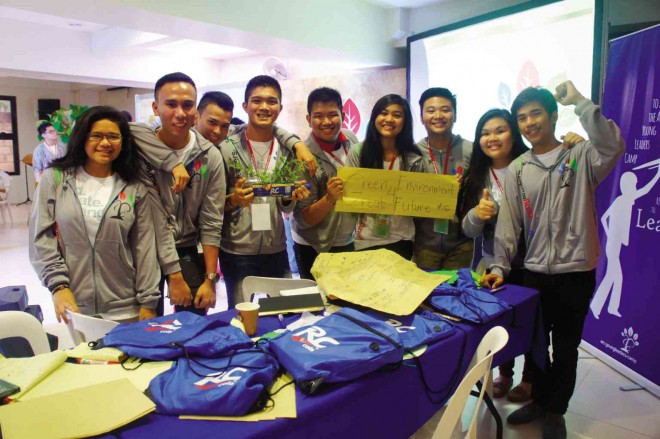A “school” built on clumps of empty plastic bottles will soon hit riverside communities to mentor young schoolchildren.
“Project Ahon,” which was developed by 10 college students, topped the project proposal contest at the fourth ARC Refreshment Corp. Young Leaders Camp (ARCYLC) in Tagaytay City.
The student-leaders, who came from different schools, said they would use their prize money to build a mobile paaralang balangay, which would go around to underprivileged river communities to help young schoolchildren.
Project Ahon members and their friends will do the mentoring.
The project is patterned after the kariton classroom of Efren Peñaflorida, which went around the slums of Cavite to teach school dropouts, particularly street children. The project made Peñaflorida the first Filipino recipient of the CNN Hero of the Year award in 2009.
Hero in their midst
Peñaflorida, in fact, was among the resource persons at the ARCYLC that brought together 39 college freshmen and sophomores from across Metro Manila and neighboring provinces. Other speakers were all champions of social service.
With mentor Bonn Manalaysay, Peñaflorida told the student leaders how the kariton classroom spawned modern-day heroes like Kesz Valdez, once nicknamed “Malas” (bad luck), who became an International Children’s Peace Prize recipient.
Mano Amiga Philippines founder Lynn Pinugu detailed how she transformed the nonprofit school for indigent students, which began in Mexico, into a self-sustaining institution with Bistro 3846.
Benedict Carandang, cofounder of Tuldok Animation Studios, talked about nationalism and how his group was slowly changing the perception that Filipino animators were second-class.
All four project proposals submitted at the close of the camp were obviously inspired by the speakers’ own projects.
Runner-up Para is also a mobile classroom, but uses a jeepney.
A proposed community greenhouse using empty plastic bottles and a cooperative producing purses from strips of plastic wrapper are designed to provide livelihood to help address the problem of poverty.
All four participating teams were formed at the beginning of the camp. They worked on their proposals in less than 24 hours, which also tested whether the various group dynamic sessions and forums during the first two days of the camp had an impact on the students.
Curt Cruz and Janine Ledesma, ARCYLC alumni and event facilitators, spoke about their experiences after the camp.
Ledesma organized a scholarship program to help students of the University of the Philippines Manila, among other things.
Cruz became a staunch advocate of Filipino sign language. He is currently working on the app Ta.Na, an electronic bulletin board for volunteer work.
“[These people] are good at what they do,” said Mark Jeremy Casqueja, a banking and finance student at Polytechnic University of the Philippines (PUP) in San Juan City.
“The simple things become big steps for the people they help,” he said.
As a future lawyer, he said he would help by defending the poor for free.
Sean Lopez, a civil engineering student at Central Colleges of the Philippines, said he and another schoolmate were planning to organize a summit on leadership, with nearby schools PUP and Far Eastern University.
“You have to move so others would,” he said.
University of Santo Tomas food and nutrition student Salina Biene Teo said, “[The camp was] very worth it … The speakers were inspiring.”
Alumni and guest speakers wrote pledges on leaf-shaped pieces of paper that were hung on a commitment tree. PHOTOS BY VAUGHN ALVIAR
She plans to be a leader in her church and school organization.
Project Ahon’s Harvin Reyes, a civil engineering student at PUP Santa Mesa, said their team was planning to visit their would-be pilot community in Pamarawan, Malolos, Bulacan, during the long school vacation.
“In the meantime, we are collaborating with the other teams … because their projects are easier to execute and they are also enthusiastic about serving communities,” he told the Inquirer.
Although participants were not required to execute their project proposals, ARC executive vice president and chief operating officer Gerry Garcia said the main priority was for the young leaders to continue their work after the camp.
“We place our efforts and resources on continuity,” he said. “It’s their call. If they want to pursue it (the project), then we’ll give them the support needed, but it has to come from them.”
ARCYLC has grown significantly since its launch in 2011 when it had only 80 applicants. This year almost 300 applied, Garcia said.
More and more schools are also joining, even screening their own applicants to ensure that the best and most passionate would join the camp.
“I attended the first camp … and … every year you see an evolution … it’s getting better,” said RC Cola International managing director Francis Lamprea. “This year, the intellectual level of the participants is extraordinary. I’m very impressed.”
Closing speaker Maria Ressa underscored the young leaders’ potential, telling the ARCYLC participants, “This generation has tremendous power.”
Ressa, chief executive officer of Rappler, a news website, said, “[Stopping corruption] is not easy. It is about leadership. It is about standing up to the status quo … [but] the more they learn to define this line now, the easier it will be later on.”
